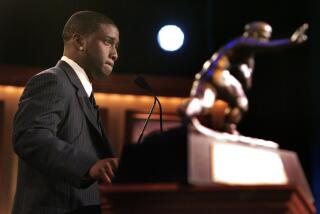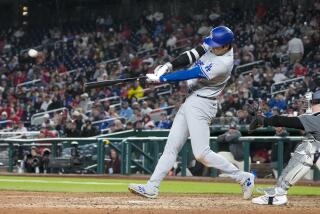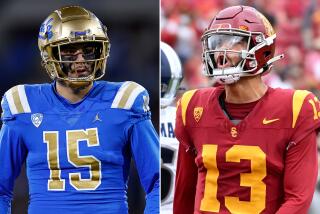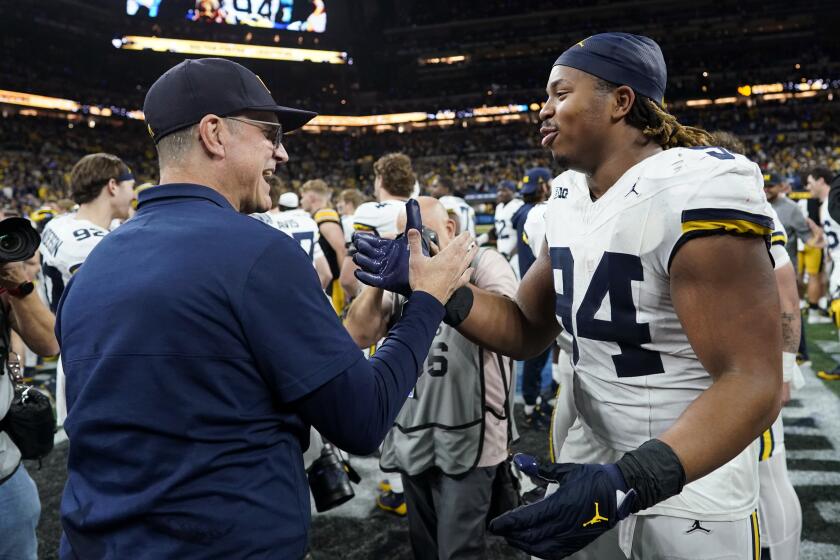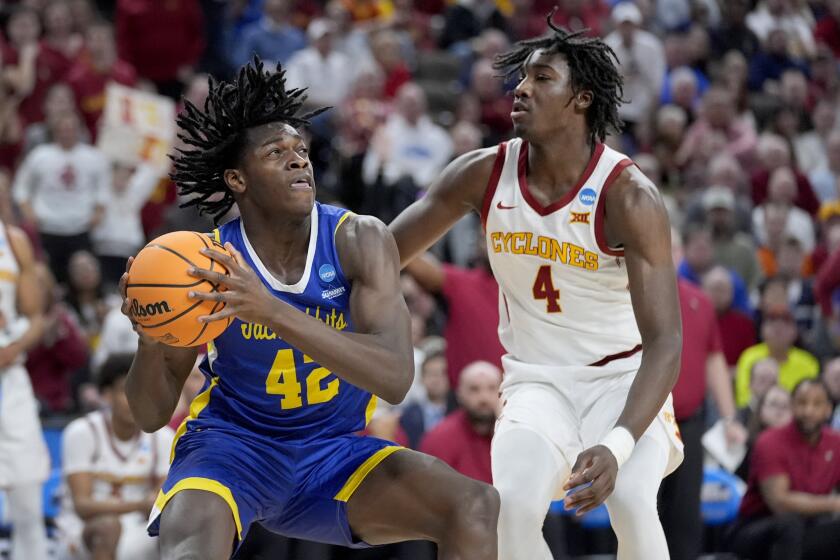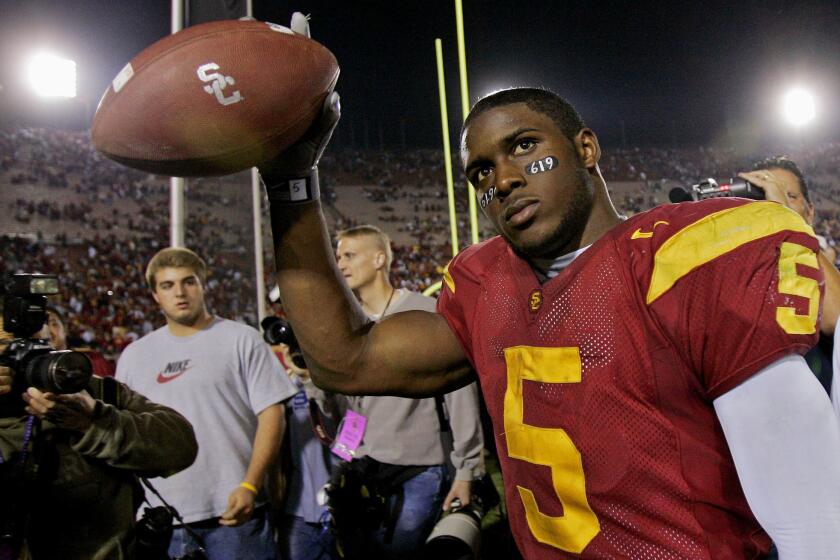Sooners and Bucs Can Throw It
Two teams with a long history of pounding the ball into the line on running plays--college football’s Oklahoma Sooners and the NFL’s Tampa Bay Buccaneers--have apparently changed direction:
In Sunday’s game at Atlanta, the Buccaneers will get an opportunity to prove they meant it when their quarterback, Shaun King, threw four touchdown passes to upset unbeaten Minnesota, 41-13.
When the Sooners toppled Nebraska, 31-14, with quarterback Josh Heupel’s passes, they definitely meant it.
For, at Oklahoma now, they have a new kind of Oklahoma coach, Bob Stoops, who came in a year ago to combine a new commitment to pass offense with his old dedication to defense.
And this year, that gives a running-play bastion--America’s football heartland--a shot at national dominance with a college team that can throw the ball.
Passes Beat the Option
As Oklahoma leapfrogged Nebraska to take No. 1 in the national rankings, Heupel, as usual, stood well behind the line in shotgun formation on nearly every play, ready to pass every time.
And in the first half, he did throw most of the time to seize a 24-14 lead.
In the second half, when Heupel still threatened continually in shotgun formation--but frequently handed the ball off--it was painful watching Nebraska’s slow-moving option offense trying to play catch-up.
Going back more than 30 years, Nebraska has regularly attacked adversaries with a three-part offense: the ground-based option game, a standard running game, and a standard passing game.
And all that time, the Cornhuskers have had trouble against evenly matched opponents--including Oklahoma’s old wishbone teams--for one reason: In a college football program, there isn’t time to properly practice the option, the run and the pass--all three.
As a passing team, the Sooners, by contrast, only have to practice two things, passing and running, so they’re more polished now than any option team.
Only when they outman an opponent can you count on option teams.
Heupel Wins Tough Ones
Oklahoma quarterback Heupel (pronounced hype-ul) is a tough, talented, accurate long passer and clever scrambler who seems in line for both the Heisman Trophy this year and a first-round place in the NFL draft some year.
At 6 feet 2 and 210 pounds, he throws a better long ball than Virginia Tech quarterback Michael Vick, who keeps his team high in the polls despite a schedule of opponents like Akron, Temple and Rutgers.
Heupel’s passes just in the last three weeks have overwhelmed Texas, Kansas State and Nebraska, all of whom also failed offensively against Oklahoma’s sound defense as developed by Stoops.
The first serious Heisman contender from South Dakota, Heupel, son of an Aberdeen, S.D., football coach is probably the best football player produced in that state since former Ram quarterback Norm Van Brocklin.
You Have to Hit Keyshawn
On the Tampa Bay team, the Buccaneers are also ruled by a defensive expert, Tony Dungy; but the difference between him and Oklahoma’s Coach Stoops is that Dungy has never seen a pass offense he likes.
Until, perhaps, the other day.
It was a good omen for Tampa when Dungy allowed King to throw the passes that dethroned the NFL’s last undefeated team, Minnesota.
During the offseason, Dungy and his front office had shown the good sense to bring in Keyshawn Johnson, who, although Tampa hasn’t seen much of him this season, ranks up there with Buffalo’s Eric Moulds, the Rams’ Isaac Bruce and a few others on the list of the NFL’s leading wide receivers.
When a good one like Keyshawn is double-covered, however, you have to fire the ball to him anyway, sometimes, as Buffalo quarterback Doug Flutie did occasionally this week when Moulds made the catches that turned back the New York Jets, 23-20.
One superior Flutie-Moulds play was, on both ends, among the season’s most spectacular.
As a quarterback, Flutie is one of the NFL’s great clutch players, but King isn’t bad, and when King went to Keyshawn six times in the Minnesota game, for 121 yards, it had to have been a learning experience for the Tampa coaching staff.
Trojans Most Influential
Pro Football Weekly’s reporters recently scouted all 31 NFL locker rooms and identified the most influential players on each team, whereupon they paid a rare tribute to USC football.
Although the Trojans are having their problems this season, they produced three All-Americans in other seasons who have gone on to unusual distinction on three different pro clubs.
Named their teams’ most influential players this fall--on the field as well as in the locker room--were former Trojans Willie McGinest, New England’s standout defensive lineman; Tony Boselli, Jacksonville’s all-time all-pro offensive lineman, and Bruce Matthews, who for 18 years has been one of the NFL’s great offensive linemen for the old Houston Oilers, who are now the new Tennessee Titans.
On other teams, there were some obvious choices--linebacker Junior Seau at San Diego, running back Emmitt Smith at Dallas, quarterback Brett Favre at Green Bay, tight end Shannon Sharpe at Baltimore--but there were some surprises too.
It turns out that Atlanta’s most influential player is running back Jamal Anderson, Oakland’s is offensive lineman Lincoln Kennedy, and Washington’s is its newest defensive lineman, Bruce Smith, who won out over a locker room full of team leaders.
When It Hurts to Win
The worst thing that could have happened to Cincinnati, which lost its first six games this season under former Coach Bruce Coslet, has happened:
Their new coach, the Bengals’ former offensive coordinator Dick LeBeau, has won his first two games to bring them up to 2-6.
There’s no chance that in the stillness of any offseason, the Bengals or any other NFL club would have hired LeBeau, a nice guy but a journeyman football man who has spent the last quarter century here and there as an assistant coach.
Now, however, Cincinnati is taking him seriously as a bona fide candidate for next year.
That’s always the danger you run changing coaches at midseason.
There’s always the chance that the new guy will do well enough to get another shot in the years ahead--meaning the football program is delayed some more into the foreseeable future.
And that’s one of the principal reasons why football coaches should only be changed between seasons.
When, for example, Oakland owner Al Davis fired former Coach Mike Shanahan with the 1989 season under way, he sent the Raiders into a tailspin that lasted for a decade and is only now ending.
You’d like to think that LeBeau will outwit the fates and emerge as the NFL’s next Vince Lombardi, but it won’t happen.
It can’t happen.
How Would Bidwill Know?
The Arizona Cardinals are still owned by a member of a family that has devoted more years and energy than any other group to the firing of football coaches in and out of season--with, as a rule, no success whatever.
That’s the Bidwill family.
The current leader is President Bill Bidwill, who on the oldest NFL club has lately replaced Coach Vince Tobin with the Cardinals’ defensive coordinator, Dave McGinnis.
McGinnis remains winless.
The great wrong with a midseason firing is that the entire blame for a losing record is heaped on one man, the outgoing coach.
In most cases, the outgoing guy actually deserves little of the blame.
Most of the time, the fault is rooted in the front office, as it has been for years in Bidwill’s office, and also in the office of Cincinnati President Mike Brown.
Neither Brown nor Bidwill has at any time ever given any indication that he can successfully operate a pro club.
Clearly, neither of their coaches, Coslet or Tobin, suddenly became a bad coach this season.
Changes, to be sure, are sometimes necessary, but the only time to make one is between seasons, which is the only time you can fairly evaluate any football man.
When Bidwill bade goodbye to Tobin, he said: “I felt it was time.”
The question then, as always, was: “How would Bidwill know?”
Rams Win with Carson, Green
The St. Louis Rams have brought back, as a consultant, their old defensive coach, Bud Carson; and in his first assignment of the season, Carson appeared to be making a difference the other day.
To return to the Super Bowl this winter, the Rams themselves acknowledge, they’ll have to play better defense in the second half of the season than they did in the first.
And, seemingly, the defensive improvement started to happen in San Francisco, where the 49ers set up one of their three touchdowns with a 68-yard kickoff return.
Thus the 49er offense hardly ran wild.
The Rams won, 34-24, after a late-afternoon advance to the red zone, where they ordered quarterback Trent Green to take a knee three times in the last two minutes.
That ended the last chance for 41-24--although Green did extend the Rams’ record string of 30-point explosions another week.
Of the old football players who sat through the game, some kept saying that the Rams were “out of synch;” but compared to the club’s earlier games this season, there were few indications of that.
The fact is that Green played about as well as injured quarterback Kurt Warner had been playing.
It’s true that nearly every week, people have looked at the final score-- and at tapes of some of the Rams’ big plays--and said Warner was unstoppable.
Even so, he’s had few wire-to-wire routs.
As good as he is--and I’d say Warner is again the football player of the year--most opponents have stopped him part of the time, some for a large part of the time.
Like the 49ers stopped Green this time.
As their usual practice, the 2000 Rams have struggled awhile and come on to win--as they came on with Green in San Francisco.
One question might be whether Green is physically put together solidly enough to last through a 19-game NFL grind.
Though he is listed at 6 feet 3 and 215 pounds to Warner’s 6-2 and 220, Green doesn’t appear to be as powerful.
Nor is he as quick.
But in his first starting appearance, Green showed that he has most of the right equipment.
He has the fast release you want, for one thing; and, moreover, there’s a lot of zip on the ball as a Green pass comes out.
He’s also pretty nimble in the pocket.
The Rams with Green are where they were with Warner--still on their way offensively--and Carson could be shoring them up now defensively.
They’re a going concern.
More to Read
Get our high school sports newsletter
Prep Rally is devoted to the SoCal high school sports experience, bringing you scores, stories and a behind-the-scenes look at what makes prep sports so popular.
You may occasionally receive promotional content from the Los Angeles Times.
